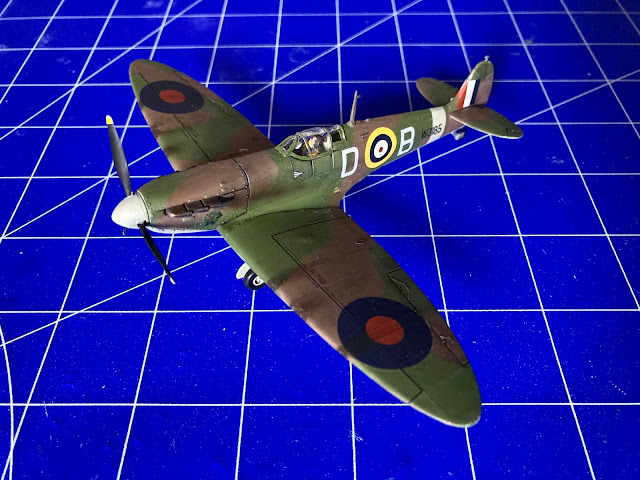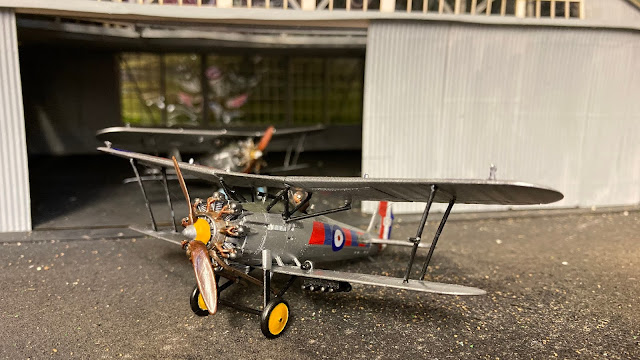In my last post, the Battle of Britain had just been won and Douglas Bader's 242 Squadron, flying Hurricanes, had just been moved east from Duxford to Martlesham Heath to join 11 Group, defending the approach to London.
It is now early March, 1941, and Leigh-Mallory, Air Officer Commanding (AOC) No. 11 (Fighter) Group, sends for Bader. He tells him that approval has been for the establishment of a Wing Commander (flying) at each of the Group sector stations. Bader is to be promoted into one of these new Wing Commander roles, with operational control of three fighter squadrons. The big wing concept, over which Douglas had fought so hard, was at last about to come to full fruition. He is given the choice of either Biggin Hill or Tangmere. Douglas selects the Tangmere station.
Bader’s Tangmere Wing consisted of 145, 610, and 616 Squadrons, all equipped with the Spitfire Mk.V. The Mk.V was essentially a compromise aircraft, rushed into service to meet an urgent requirement for a fighter with a performance superior to the latest model of Messerschmitt, the Bf 109F. It, however, failed to provide the overall superiority Fighter Command needed so badly. At high altitude, where many air combats took place, it was found to be inferior to the Bf 109 on most counts, and several squadrons equipped with the Mk.V took a severe mauling that summer.
In July 1941 the Wing received delivery of the Spitfire Mk.Vb. These replaced the eight machine guns of the Mk.Va and earlier variants with four machine-guns and two 20-mm cannon. The cannon arrangement enabled pilots to open fire at much longer ranges, and from the outset Bader did not like it; he had always been a staunch advocate of close-in fighting, and maintained that the cannon would tempt a pilot to open fire from too great a distance, with a consequent drop in the chances of success. Even when the Wing was fully equipped with Mk.Vb he stubbornly persisted in flying a Mk.Va, which was armed with machine-guns only. He always claimed that he never managed to score any hits on anything when flying a cannon-armed aircraft. He was wrong, but stubbornly refused to admit it.
During the summer of 1941, Bader's Tangmere Wing flew target support missions over Northern France. On Saturday 9th August, 145 squadron was to fly top cover and was first away, followed by 616 and 610. Bader was flying in Red Section of 616 Squadron. Each aircraft were recognisable by the code letters that identified the squadrons to which they belonged: SO for 145, DW for 610, YQ for 616, and Bader, as Wing Leader, carried no code; only the large letters DB, one on either side of the fuselage roundel. 145 Squadron missed the rendezvous point, reducing the Tangmere Wing by one-third of its strength; nevertheless, its task was target support, and there could be no question of calling off the operation. Together 610 and 616 Squadrons set course over the Channel and in land from Le Touquet to the airfield of Bethune-Labuissière, the target of the Bristol Blenheims they were protecting.
Red Section, like the others, climbed in finger four formation. It resembled the outstretched fingers of a right hand, with a Spitfire at each fingertip; from left to right, it was Flying Officer Jeff West, a New Zealander; then the Wing Leader; then Cocky Dundas and finally Flying Officer Johnnie Johnson, who one day would make a name for himself as the RAF’s official top-scoring fighter pilot. It was a truly formidable quartet.
The Spitfires were at thirty thousand feet when twelve Messerschmitt 109s (BF 109)were spotted prowling about two thousand feet below. Having the superior height advantage, Bader's Spitfires were beautifully positioned for a ‘bounce’. He took Red Section down in a steep dive towards the centre four Messerschmitts. The German pilots, fully realising their peril, broke away hard in all directions and individual dogfights spread out across the sky.
With the melee done, the Spitfires landed back at Westhampnett, Tangmere’s satellite airfield just north of Chichester to refuel. All the Spitfires of the Tangmere Wing were accounted for, all that its, with the exception of Buck Casson, Blue Section, and the Wing Leader, Bader, both of whom were missing somewhere over France.
Almost forty years later, in Fight for the Sky, Douglas Bader himself described what had happened to him that morning, high over France:
He said that he did everything wrong. He signalled ‘attacking’ and dived down too fast and too steeply. He closed so fast on the BF 109 that he had no time to fire. Levelling out at 24,000 feet, there was then no one in sight, he was alone in the sky.
Ignoring his own advice to pilots when alone, which was to get down to ground level and fly home, and noticing a couple of miles in front at the same height three pairs of BF 109 he dropped down just below them and closed in to attack. Oblivious to this lone Spitfire's presence, the back one of the middle pair was destroyed with a short burst of machine gun fire from close range. Bader was just opening fire on the second when he spied the left hand pair of BF 109 turning in towards him. He thought, now was time to go home.
He then made his final mistake. The rule is: always turn towards your enemy, never turn your back; if you do, you lose sight of your enemy and present yourself as a target. The remaining pair of BF 109 to his right were still flying straight and level, so he turned towards them, intending to pass over the top or even behind them, so that he could then dive away for home in the opposite direction. At this stage there was no problem ... but this was a morning dogged by bad judgement and it wasn't over yet. Banking hard over to the right he crossed too close to the second BF 109 collided and lost his tail!. Had he turned left towards the enemy coming at him, as was the rule, there would have been no danger, except from a lucky bullet!
Bader managed to get out of his Spitfire, less one leg which had got caught somewhere in the top of the cockpit. He had sustained two broken ribs and lacerations to his throat and one hand when he landed. Douglas was taken to a hospital in St Omer, where once as he recovered from his injuries, he attempted the first of many escapes. It was not long before Bader was recaptured and while he never managed to successfully escape back to Britain, he never gave up trying and did his uppermost to be as much of a nuisance to the German authorities as humanly possible. The fact that a year later, on 18 August 1942, he was confined to Colditz castle, the forbidding fortress perched high on its rock some twenty-eight miles south-east of Leipzig, is testament to how successful Bader was at this.
On 13 April 1945, the prisoners were awakened by the roar of aero-engines as American Thunderbolt fighter-bombers swept overhead, diving down to strafe some unseen target as armoured spearheads of General Hodges’ 1st US Army, approached from the west. All night, shells screeched overhead as the Americans battled it out with the SS, who were positioned behind a ridge to the east. At about eight o’clock in the morning of 16th April, the Americans liberated Colditz. Douglas had been a prisoner for three and a half years.
For my Douglas Bader Spitfire Mk.Va, I had to use Airfix's 2002 release of their Supermarine Spitfire Mk.I kit. No one, as far as I could make out has ever made a MkVa and as the Mk.I was visually similar to the Mk.Va, in that the latter just had an uprated engine, it made sense to use this as my base kit.
The DB code letters and W3185 serial number decals were an after market purchase and I again used the Ammo MIG early WWII RAF colours - despite their overt brightness - to complete this build of the Spitfire Mk.Va in which Douglas Bader crashed out of the sky over France in the summer of 1941.
----------
The model:
Brand: Airfix
Title: Supermarine Spitfire Mk1
Number: 01071
Scale: 1:72
Type: Full kit
Released: 2002 | Rebox (Changed box only)



































